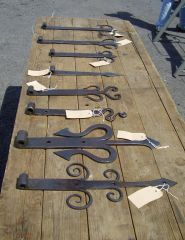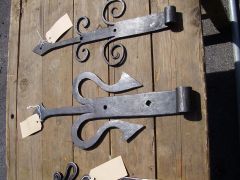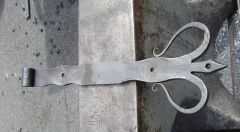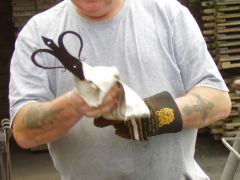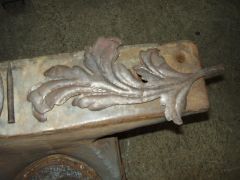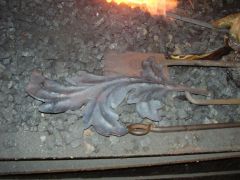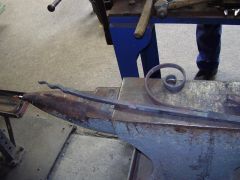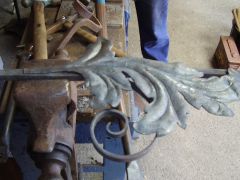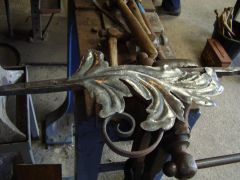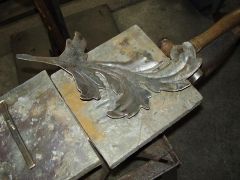-
Posts
3,598 -
Joined
-
Last visited
Content Type
Profiles
Forums
Articles
Gallery
Downloads
Events
Everything posted by John B
-
-
-
-
-
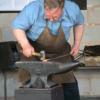
Another home made fullering and whatever tool
John B replied to Frosty's topic in Blacksmithing, General Discussion
Hi Frosty, don't want to put a downer on this, but I made one similar using 1/2" x 2" spring steel for blades/dies, the problem I found was they are just that bit short for making tenons etc, but ideal for cut off and veining, so I had to make another with a larger set of dies, I used 1" x 2" stock and found this much better. Good idea on the 45 degrees though, allows more versatile access. Thanks for your prolific postings, Always useful and informative as well as enjoyable. -
wine bottle warmers
-
The trick is to shut off the air blast and leave the fire for a few minutes to allow the clinker to solidify into a solid lump, then lift it out with the rake or slice, this should not disrupt the fire too much, then bring hot embers back to fire pot hot spot and bring air back up. It is far easier to hook out in a solid lump, and patience is its own reward in this situation, the last thing you want is clinker dispersed through the fire, not good.
-
Soak it and let heat penetrate and it should be uniform throughout. Easier to do in a gas forge, fire control is essential in coke/coal/charcoal forge.
-
If you have an air blast from the side, because of the intense heat if you are using coke or firewelding a lot, you will need to put a water tank on to prevent the tue burning away. The pictures show a portable set up that should illustrate what is needed
-

Forming a leaf and fixing to scroll2b Forming veins
John B posted a gallery image in Member Galleries
-

Forming a leaf and fixing to scroll 2a Forming veins
John B posted a gallery image in Member Galleries
-

Forming a leaf and fixing to scroll 3 Scrolls formed and firewlded together
John B posted a gallery image in Member Galleries
-

Forming a leaf and fixing to scroll 4 Raised leaf ready to pin in place
John B posted a gallery image in Member Galleries
-

Forming a leaf and fixing to scroll 5 pinned on, wire brushed and waxed
John B posted a gallery image in Member Galleries
-

Forming a leaf and fixing to scroll 1 cut to shape and lined out
John B posted a gallery image in Member Galleries
-
Stack plates and jig saw, plasma, oxy acetylene, chisel, or nibbler, It helps to drill small holes at base of petals to cut into
-
Would that be similar to a ressurection? Or simply that just because its been in a cemetary, its life cycle is not yet over? Plenty of metal gets ressurected from the scrap pile after it so called useful life, and goes on to be useful in other forms. Just another wonder of a life cycle, Don't scrap, recycle (sometimes its dang hard to pedal though)
-
What size flypress are you talking about? Is it a forging press as opposed to a flypress? (Speed of ram travel is the main difference) Normally flypresses have a very rigid frame, and sit on a "table" or similar with access through the base to allow punched out blanks to be removed. Which means the main impact is taken around the base and not in one compact area as under a power hammers tup. Deflection of base / bolster plate I have not found to be a problem, the torque imparted when using them is usually more of a problem, and they have to be secured firmly to stop them walking round in use. As for a base, I have them securely mounted onto a table which is firmly bolted down and has a top made of 3" thick timber with a 1/4" steel plate on top between the press and timber preventing the flypress compacting the wood and allowing it to "bed in", it also helps to have large steel washers under the table top to secure press in situ with suitable nuts and bolts The table also has holes through to allow blanks to drop out when punching out shapes. The one I use mostly for forgework is mounted on a steel plate top,(again with a hole through) supported by structural channel sections at a convenient height, and then welded to a base plate which is firmly secured to the floor. The channel is directly under the press's base casting which leaves access to the blanked out parts.
-
Cut it up and it makes feet for a table, I know someone out there viewing this has got one made like this, so come on, You know who you are, post a pic !
-
Staedy gents. You all should know that the time to take up anything is when you are young and you know it all! The longer you are doing anything, you realise the less you know about it. That's experience, you can't teach it, just pass it on. Still learning, be dead when I'm not.
-
I would think that you could use your existing rollers as they are. I assume they are powered? Just feed in your bar and put a gentle, regular curve in, then turn the bar the other way and adjust the rolls to neutralise the curve and it should come out relatively straight. I have done this in the bonding machine shown and it works succesfully, however if the bar is twisted, then it becomes a little more difficult. Two or more passes may be needed
-
Hi Valentin, some suggestions. Bonding machine, Jim Crow, flypress, or when you are texturing the bar straighten it as you go. Bonding machines, are used to produce iron tyres for wooden wheels, (now known as ring rollers they can be purchased as a modern powered machine) they are a mini version of levelling rollers as used in steel mills for levelling/straightening bars as they come from the strip mills. Ideal for hollow sections as it is easily controlled pressure that should not collapse the tube as it may do if direct pressure is applied to a point. Jim Crow (Don't know why they are called that, but no doubt someone on the site will) come in various sizes and were used for straightening bars up to railway line size. You could adapt this frame configuration and mount an eccentric roller on a lever where the screw is shown to reduce the time taken to apply the screw principle. Fly press, one of the best versatile tools for the workshop, depending on how badly the bars are bent, two bits of curved top handrail section, one at each side, and another piece mounted on a top tool, should prevent the textured finishes getting marred. Just feed it through and press it level. Finally, if you are texturing a bar, can't you just keep it straight as you are going along its length?

